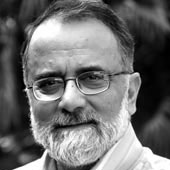Pakistan on the Brink: All Crisis, No Potential?
How are Pakistan’s internal and external conflicts holding the country back from its economic potential?
March 23, 2012
In the military’s view, Pakistan is constantly threatened by outside enemies, in particular India — but at times also Afghanistan, Iran or the United States. In order to stand up to this perceived threatening environment, it maintains an army of 600,000 men, the seventh largest in the world. Its total security forces number more than one million men, armed with nearly 100 nuclear weapons.
The military consumes between 25% to 30% of Pakistan’s budget. It is able to secure those state resources because the political elite is supine and corrupt, parliament does not insist on accountability, and the army retains control of foreign policy, national security and the nuclear arsenal. No enlightened military leaders have arisen to try to change this status quo, despite the spread of democracy and the demise of other authoritarian governments around the world.
Pakistan has become an abnormal state that uses Islamic militants — jihadi groups, nonstate actors — in addition to diplomacy and trade, to pursue its defense and foreign policies. These nonstate actors have deeply antagonized its neighbors, all of whom have, at one time or another, felt their pressure.
After September 11, 2001, the army’s policies did not change, even though the whole world was now deeply aware of the threat posed by Islamic extremist forces and were less than tolerant toward them.
Yet Pakistan’s location gives it enormous geostrategic potential. It borders Central, South and West Asia, is a gateway to the sea for China, and is situated at the mouth of the Arabian Gulf. No other country in the world has such potential to become a hub for trade and business or the transcontinental transport of energy.
Even India would find it far more useful to use Pakistan as an investment hub, and a leaping-off point to access Central and West Asia, than to be in conflict with it.
The country lacks major natural resources like oil, but if it were at peace with its neighbors and with itself, Pakistan would become the great trading crossroads of the world, ensuring stability in the region. Islamic militant proxies would have no need to terrify the country’s neighbors.
Yet the army and the political elite have never tried to create such a Pakistan. They have always perceived the country as vulnerable and indefensible, and regarded every other government as a potential threat.
Because of these fears, they support strategic depth and a pliable Afghan government that could aid Pakistan in times of war with India. This is an absurd theory that nonetheless persists and prevents the military from developing a rational policy toward Afghanistan.
Punjab dominance
Another factor perpetuating Pakistan’s fragility is the inability of its ethnic groups to find a working political balance with one another, and the failure of its political system, its parties and its army to help them do so. Punjab, the second-largest province geographically, contains 60% of the country’s population. Seventy percent of the army and a large part of the bureaucracy are drawn from Punjab. Punjab is also the most ethnically homogenous province, with the vast majority of its population being Punjabi.
The Baloch, Sindhis and Pastuns have at one time or other all felt underprivileged and resentful of the Punjabis. As a result of Punjab’s dominance, resentment from the smaller provinces has ebbed and flowed over the years. They have mounted everything from political resistance and civil unrest to terrorism and separatist guerrilla wars.
The current insurgency in Baluchistan province is the fifth of its kind. Hence, the absence of a shared national identity that transcends ethnicity, tribe, religion and language is a lingering problem for Pakistan. If Pakistan were a trading hub and a regional crossroads, using all its territory, all its ethnic groups would have a stake in it.
The military and the political elite are both to blame for perpetuating these factors and for failing to forge Pakistani unity. The major political parties are run as family dynasties rather than democratic institutions. They have rarely offered modernizing policies that would reform the economy or society. They have rarely tried to live up to their responsibilities to the people.
Civilian rule in the 1990s by Benazir Bhutto and Nawaz Sharif — who were twice popularly elected to power and twice deposed by a combination of the army and the presidency — made Pakistan a byword for corruption and mismanagement.
The politicians’ failure has sustained the army’s strong anticivilian prejudice and more recently fueled public antagonism toward politicians and the democratic system. Such conditions have only helped Islamic extremists present themselves as incorruptible, clean alternative rulers.
These internal conflicts within the country’s elite have prevented the rulers from noticing major shifts and challenges in the global environment. They have allowed history to pass them by, with the result that Pakistan has missed out on all recent global developments.
Editor’s note: This article is an excerpt from Pakistan on the Brink: The Future of America, Pakistan, and Afghanistan by Ahmed Rashid. Reprinted by arrangement with Viking, a member of Penguin Group (USA) Inc. Copyright © 2012 by Ahmed Rashid.
Takeaways
Pakistan has become an abnormal state that uses Islamic militants, in addition to diplomacy and trade, to pursue its defense and foreign policies.
Even India would find it far more useful to use Pakistan as an investment hub than to be in conflict with it.
If Pakistan were at peace with its neighbors and with itself, it would become the great trading crossroads of the world, ensuring stability in the region.
Read previous
A Brief History of Supply Chains
March 22, 2012
